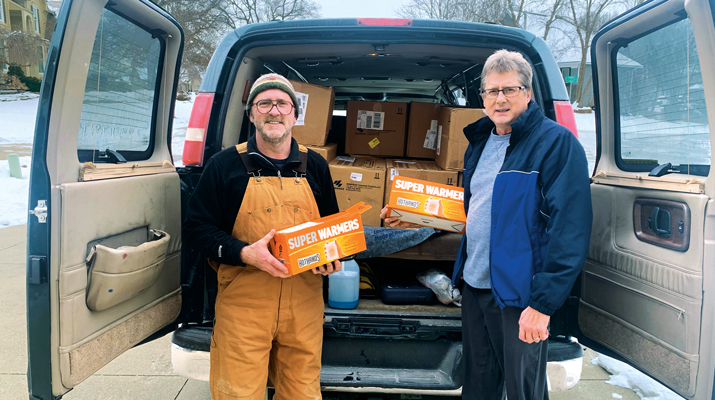Retailers coping with challenges of record-low temperatures
A later-than-usual crop drying season. Significant supply delays at propane terminals. And then a sudden polar vortex and its dangerously cold wind chills.
Business has been unusually challenging in the Upper Midwest for propane marketers these last few months, and the record-cold temperatures that swept across much of the United States last week left their imprint on the industry.
“Once we got out of grain drying it turned cold and stayed cold,” says Scott Long, manager of propane marketing and business development at Growmark, which is based in Bloomington, Ill. “It’s affected supply inventories.”
As an example of how the continuous cold has contributed to the Upper Midwest’s short supply, Long says competitors have contacted Growmark wanting to purchase its propane because they’re struggling to source it elsewhere.
“If you go up to Wisconsin where they were minus 8 for a week, there’s not a whole lot you can do,” Long says. “Instead of filling tanks all the way, they’re filling them halfway. So now you have to make deliveries twice.”
Temperatures have not been as consistently frigid in Ohio this winter as they have been in the Upper Midwest, but last week’s sub-zero temperatures presented new tests to propane marketers.
“They’re calling this a 20-year storm; I think it’s more like a 40-year storm because we haven’t had this kind of blowing and drifting since 1978,” says Allen Dunlap, president of Linden’s Propane Service in LaGrange, Ohio, in a phone interview last week. “I don’t remember it ever being this bad and this cold. As an industry our customers have come to expect a certain level of service, but in storms like this you just can’t meet that expectation.”
According to Dunlap, Linden’s Propane was bombarded with phone calls from customers last week. Many of the company’s customers operate via will call, and that dynamic created challenges considering how quickly propane was being consumed. Usage among Linden’s customers was up anywhere between 28 and 38 percent because of the polar vortex, Dunlap says.
“I know we’re going to have some concerns this spring with pre-buy customers,” he says. “I guarantee they’re going to use more than they [pre-bought]. Everybody is price sensitive, but when you only buy 800 gallons for somebody who’s going to use 1,000, there’s going to be some sticker shock for customers.”
The key to easing customers’ pain is letting them know how their bills will be affected, Dunlap says.
“At least then the [bobtail] driver’s not going to get the door slammed in his face,” he says. “You’ve got to be upfront with them.”
A door in the face was probably among the least of a bobtail driver’s concerns last week, though. Bobtail drivers were probably more concerned with staying on driveways and avoiding ditches, as well as avoiding obstacles on icy roads that typically present challenges this time of year.
“We had a big meeting, and I always have a little memo I type up and send out saying remember the basics,” Dunlap says. “We work as hard and as fast as we can – safely. You don’t take unnecessary risks. The biggest obstacle in our way is other cars. Kids are all out of school and many are out on the roads texting their friends. We monitor what we can, but it’s the factors that are out of our control that are most concerning.”
Unsafe driveways, like teenagers texting while driving, are concerning.
“You can’t see driveways,” Dunlap says. “Customers expect a high level of service and quality, but some customers don’t bother to [clear] their driveway.”
Cold as bitter as last week’s presents challenges to company vehicles, says David Anderson, a district manager for Lakes Gas in northern Minnesota.
“Equipment tends to not work correctly and break in these temperatures,” he says. “We have more breakdowns and things happening when they’re out in the field in these temperatures.”
Planning ahead helps ease the pain when winter is at its worst, adds Michael DeVoe, executive vice president at Paraco Gas.
“We always plan for the harshest of winter conditions,” says DeVoe, whose company’s call volume jumped 40 percent overnight because of the storm last week. “So far this year our extensive planning has certainly paid off. As soon as the severe weather conditions hit the Northeast, our teams sprang into action.
“We opened our customer service centers seven days a week from 7 a.m. to midnight – our answering service covers late-night and early-morning emergency calls. We restructured our delivery and service hours to multiple shifts with extended hours; we engaged our sales professionals to assist with customer care matters; we increased our manpower with additional customer service reps and delivery professionals; and we updated our website daily with helpful safety and energy conservation tips for our customers. We accomplished all of this without risking safety and fully complying with all local, state and federal guidelines.”
Yes, barely two weeks of the new year’s gone by. And winter’s legs are likely to extend a few more months. But based on the weather so far, how will the industry look back on this winter come spring?
“I would say, from a propane standpoint, we will say it was a very good year – but it was one of the most challenging we’ve ever seen,” Long says. “We’re seeing a lot of challenges, but we’re getting through those.”
Photo courtesy of Corey Templeton, Foter.com.
















